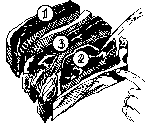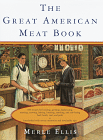
Bruce "Tog" Tognazzini.
Ask Tog, January, 1999$1.69 SteakDid you know that your local food store is probably selling high-quality steak for around $1.69 a pound? Did you know that most people try to avoid it, instead opting for the $2.00 a pound meat just next to it that is tough as nails or the $10.00 a pound steak that is identical? I learned this trick years ago from Merle Ellis, the host of cable TV's Cookin' USA and author of The Great American Meat Book. Like all of Merle's tricks, it's real and it can save you equally real money. The most familiar chuck roast particularly to those of us in the Western United States is the "7-bone chuck," so-named because one of it's two bones looks like the number 7. It is the tough-as-nails roast just next to the roast we've been overlooking all these years.
The blade chuck consists of three distinct types of meat, two of which are steaks normally sold at a premium—a Flatiron steak and a Market or Spenser steak. This latter is considered by many as the finest cut of beef available. Identify the blade chuck by its two major characteristics. First, the blade-shaped bone at the top of the roast, which should not have any protuberations on it (otherwise, it is a center-cut or seven-bone chuck). Second, the words, "blade chuck" on the supermarket packaging. (This latter is less reliable.) When you get the roast home, divide it into its three pieces, removing the bones in the process.
Second, the steer has been kind enough to provide a line of fat as a guide to removing the market steak (2) from the remaining meat (3). Just cut along the white line to separate the steak. You may then cut the steak away from the chine bone that lies along the bottom or you can barbeque the whole thing up, bone-on. Either way, you will be eating a premium steak at hamburger prices. As for the remaining cut, it is excellent for pot roast or boiled beef or any other recipe that calls for long, slow cooking. And speaking of long, slow cooking, tough meat comes out better the slower you cook it. Microwave ovens, of course, spoil any meat, but so do pressure cookers, though not as badly. Boiling up meat over a hot flame is just about as bad. The real way to do it is to simmer the meat for six to eight hours, the way Mom used to do in the crock pot. That allows the connective tissue to let go of its strangle hold without the muscle cell walls turning into concrete. I often buy a couple of blade chuck roasts at the same time. That way, I get enough of each cut so I don't have to skimp on each night's eatin'. And if I don't want beef three nights in a row, I'll have a nice Market steak dinner and separately freeze the boned-out Flatiron steak and the future pot roast for later use. Any way you cut it, it's a great deal.
I heartily recommend Merle's book as one of the fundamental books for your kitchen, right beside Joy of Cooking. You'll save far more than the purchase price through his money-saving hints. Find it at your local book store or click for the AskTog-Amazon discount price.
|
|
Don't miss the next action-packed column! Receive a brief notice when new columns are posted by sending a blank email to asktoglist-subscribe@yahoogroups.com. |
| Contact Us: Bruce Tognazzini Copyright Bruce Tognazzini. All Rights Reserved |


